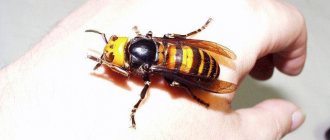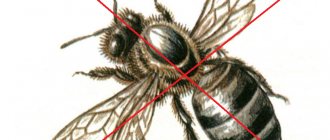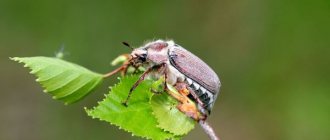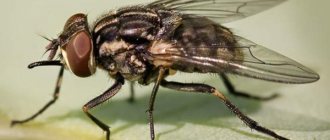What you need to know about hornets and bees. The war between insects, why this happens. How bees resist a huge enemy and what methods of defense they use. How can they kill a hornet? Other enemies of hornets. Which insects become their victims?
Many of us consider hornets to be true predators and are confident that these large insects are waging a real fight against honey bees. A lot of information that is presented for general viewing does not show hornets from a very good side, where one individual can easily withstand tens and even hundreds of bees, while destroying them.
There is some truth in this; a few hornets can really completely destroy a bee colony. But you shouldn’t take everything the way it is presented. In fact, there is no war between them, and the hornets do not want to destroy their population at all, everything is much simpler and more banal. You just need to get to know these insects a little better.
Hornets vs honey bees
It will not be a revelation to anyone that these bright and huge insects have long been labeled “killers”; this statement, of course, applies to insects. But this label was assigned not entirely fairly, even, one might say, incorrectly. They do kill other insects, but this is a kind of hunting and not for fun, but for the sake of feeding their offspring.
Nature has decreed that in order to continue the population, they need to regularly go hunting and get new food to bring to the nest and feed the offspring. It is not their fault that their diet consists of other insects.
And the point is not at all about bees; they, like other insects, simply serve as food for their family. It is worth saying that they even hunt small frogs, since nature has awarded them with strong and large jaws.
Having figured out why they kill insects, you can understand that they received the title of killers completely undeservedly, because in this case this title can be assigned to ants. After all, goosebumps also constantly bring home bugs, larvae, caterpillars and other insects, but no one labels them “killers.” Perhaps the reason is that the struggle of a hornet is much more spectacular than that of an ant.
It is worth saying a few words about why hornets choose beehives. In fact, in this matter everything is very clear and simple - this is an ideal feeding place. A large number of individuals gather in this place and they are easy to catch, which reduces the time spent searching for food.
It is also a valuable nutritious product, which is important. Well, one more important point: there is always the opportunity to enjoy honey, and the diet of adults consists mainly of sweet foods.
How one can understand the choice of bees as a hunting object is completely understandable. The presence of at least one hive in the hornets’ habitat provides the entire colony with adequate nutrition, and they obtain food without much effort.
You should not think that they specialize in killing bees; they hunt completely different insects, but they will not refuse such healthy food, especially if the hive is nearby.
Methods of disposal
Once a hornet settlement site has been discovered, one of the possible options for getting rid of such an unpleasant neighborhood should be considered. There are several options, so there is plenty to choose from in each case.
Traps
A bucket of water can act as a trap for the simplest device. If the nest is located directly under the roof or next to the home, you can lower it into a bucket filled with liquid. But since you need to withstand a certain period of time, and holding a filled container is quite dangerous, you can simply place a ladder on which a bucket of water is placed.
The following types of store-bought traps have also proven themselves to be effective:
- Argus garden - it is placed no closer than 20 m from the nest. It must first be filled with an attractive liquid, which can be fruit juice, diluted honey or beer. You also need to make sure that it is located in a place protected from the wind.
- The second trap option is Wasp Trap Swissino. There is already bait here, and the design itself guarantees that an insect will get into it, from which the hornet will no longer be able to get out. The only thing that needs to be done is to control the volume of water in which the insects will drown.
Chemicals
Of course, you can use an insecticide. But in this case, all precautions must be taken very carefully so as not to harm the bee colony.
Most often, a suitable chemical is selected and sprayed inside a plastic bag. Then they wrap this bag carefully, taking all precautions, around the hive and leave it for a certain period of time. The exposure time should correspond to the recommendations on the packaging of the drug. This is a fairly effective way to get rid of uninvited guests.
If the hornets' nest is in a hole, then you can pour liquid chemical into it. But in this case, it is necessary to take into account one feature - the depth of the hole can be quite large, which will require a significant volume of liquid insecticide.
Among the most commonly used types of drugs:
- Deltrin.
- Xulat.
- Jurax.
- Get.
- Taran and others.
Meat
If meat is treated with any kind of poison, then the colony can be infected in this way and, most importantly, the young insects can be destroyed. But it is important to consider that for this method to be effective, it is necessary to lay out the poisoned meat for several days to ensure maximum spread among the population.
The disadvantage of this method is the possibility of poisoning pets or the threat that children may be in close proximity to the shipped product.
Water and fire
Water is quite effective. With its help you can destroy hornets in the nest and hole. In addition, this method does not threaten the surrounding nature and cannot cause a fire, as is the case with fire. True, there is a possibility that some insects may survive.
Some people prefer to use the effect of fire. For this:
- Or make a torch out of newspaper and stick it in the center of the hive.
- Or they pour kerosene or gasoline on the nest and set it on fire.
In both cases, there is a possibility that nearby objects will catch fire. Therefore, it is necessary to carry out this manipulation with all precautions.
Folk remedies
One of the popular ways to get rid of a colony, if it lives in a hollow, is to simply wall it up with putty.
Another folk recipe is to mix 45 g of honey and a bag of boric acid in 50 ml of warm water. Place the “treat” prepared in this way in close proximity to the hornets’ nest and leave for several days.
Pest control services
If for some reason you cannot exterminate the hornets in your apiary, you can call a pest control service to help deal with this problem. But in this case there is a fairly serious threat to the apiary itself.
Therefore, most often this method is resorted to only if these insects threaten only humans and not bees.
Hunter and prey: hornet and bee
These insects belong to the same order of Hymenoptera, which also includes wasps, bumblebees, as well as riders and ants. All of them are united by certain behavioral features, as well as similarities in appearance. In addition to some similarities, there are also many differences.
So, we all know about the presence of a poisonous sting in hornets, wasps, bees, and bumblebees. Regarding ants, the tropical species has a sting and it is worth saying that their bite is the most painful. The poison of each of the representatives is toxic, dangerous to humans and has similarities in its composition.
Despite the similarity, the poison of each representative has characteristics that are decisive at the moment of impact on the human body. What this means can be seen with an example.
Hornet venom has a stronger effect on nerve receptors than others; it has a high level of allergenicity. Bee venom is different in that they release a large amount of toxin at one time, which causes severe poisoning.
It is worth saying that different species have different poisons. For example, the common hornet, which is familiar to us, is capable of inflicting a very painful bite, but its poison will not cause serious consequences, unlike the poison of the giant Asian hornet, which is one of the most dangerous representatives on Earth.
Regarding hunting their victims, in this case they do not use poison, as you might think, they use no less dangerous strong jaws. It is also worth noting that hornets are very smart and cunning, this can be seen if you consider the hunting process.
They do not attack their victims who are alone. After all, it would seem that a bee that is busy collecting nectar is very easy prey, but they do not attack them. Cunning predators watch their prey so that it leads them to their hive, and then return to it in large numbers.
In order to completely destroy a bee hive, a different number of attackers is required and this directly depends on the type of predator. But this rule has its exceptions.
If we consider the behavior of the European species, then several hundred of these individuals are capable of destroying a hive in which there are about 10-15 thousand bees. But this is theoretical, since in practice the situation is somewhat different.
The fact is that in our country it is very rare for families of hornets to reach such large sizes. For this reason, in rare cases they can attack entire hives, and more often attack single bees. But such attacks also cause great damage to apiaries.
But if we talk about their giant relatives, Asian murder hornets, whose size is 2 times larger than European ones, really pose a great danger. Unfortunately, bees are absolutely helpless against this species. Let's look at this view in more detail.
Giant hornets and their hunt
The undoubted difference between these huge insects, and at the same time their superiority over their relatives, is their size. They reach more than 5 centimeters in length; to understand how large these are, you can compare them to a worker bee, which is 3 times smaller. They attack their victims with powerful jaws; one movement is enough to break the joint of the chest and head, which leads to paralysis of the bee.
For a bee hive, they pose a huge danger, since in 1 minute just one predator can kill about 30 bees, and in order to destroy a hive of thousands, 30-40 predators are enough, which will deal with it in a few hours.
Hornets have a very hard chitinous body cover and it is practically invulnerable to bees, there are only a few places where they can pierce it with their stings, but even in this case, they will not cause much harm to the predator. In turn, predators very rarely use their stings.
In fact, for hornets, finding a hive and destroying it completely is a “tidbit,” so they do it with great pleasure. It is worth saying that the war between these insects was not started by nature, it was provoked by man and it is he who is to blame for the active extermination.
Bees' capabilities: defense is their secret weapon
Speaking about the types of these insects, it is worth understanding that some of them have never waged war with each other and do not even suspect the existence of relatives, and all for the reason that they live in completely different territories. For example, the Asian hornet, which lives in Southeast Asia and Japan, will not meet with the European honey bee, which lives in the Middle East and Europe.
But there are also Asian bees that use a rather original method in the fight against their relatives; it was developed in the course of joint evolution. So, when a predator is preparing an attack, the victims attack him themselves and in this case take advantage of the advantage of numbers. They cling to it from all sides, potential victims form a huge ball with a diameter of up to 30 cm, while each bee actively flaps its wings.
It seems that they cannot cause much harm to their enemy, but in reality this is not the case. The fact is that from such flapping of the wings, the temperature of the air inside the ball begins to rise.
In addition, the movement of the wings directs the heat to the center of this ball, where the enemy is located. A temperature of 46-47° is lethal for a predator, so it can stay in the middle of the ball for a maximum of an hour and then die. The owners of the nest can normally tolerate temperatures up to 50°, so they will not be harmed in any way.
For one such ball, about 500 bees are needed and the enemy is defeated. If we talk about a family, which on average consists of 15-20 thousand individuals, they can easily withstand 30-35 predators. This cunning method of defense is very reliable and effective against your enemies.
But European bees that live in our country do not use such a defensive method. This is due to the fact that hornets attack honey beehives in the wild very, very rarely, almost never, so there was no reason to develop such behavior.
But our bees can boast of another feature, namely the ability to collect large amounts of honey. Japanese beekeepers are trying in different ways to breed them in their territories where there are giant predators.
As mentioned above, war between relatives is not a natural phenomenon; it was provoked by man. The attempts of Asian beekeepers are unsuccessful, since predators destroy the hives they find, and the bees simply do not know how to protect themselves. It is not for nothing that nature has divided the species of these insects, and forced relocation leads to the death of a large number of insects.
Hornets against bumblebees and other insects
It’s worth saying right away that for a hornet, any insect that is inferior in strength and has a smaller size is considered as a potential victim, and the bumblebee is no exception. Just like a bee, a bumblebee is defenseless against this predator, the only difference is that killing this victim will require a little more effort.
But the types of insects are also important here, since an Asian one can attack a bumblebee without hesitation, but a European one is unlikely to attack, for the reason that it will most likely be frightened by its size. They are approximately the same size and it is very difficult to say which of them is stronger, but there is a very high probability that the bumblebee will still survive.
It is a completely erroneous opinion that these insects are enemies. Here, rather, nature brought them together and forced them to tolerate each other. The bumblebee, by its nature, is very peaceful and is not a predator, so an attack on its part is out of the question. But at the same time, he is a large insect, which at the right time will give a worthy rebuff.
Let's find out how relationships with other insects develop:
- Wasp. Also considered as a victim, she is comparable in relationships and in the process of hunting with a bee, since she is defenseless in front of him. Their nests are attacked only in rare cases; they are also predators and, gathered in large groups, can fight back.
- Mantis. This insect cannot resist its opponent in any way; it is absolutely helpless. All he has are powerful legs, but they cannot harm the enemy in any way. When attacking a praying mantis, the hornet does not use its sting, there is no need for this, it simply bites through the joint in the neck area.
Hornets vs bumblebees: who is stronger when they meet?
The relationship of giant wasps with other insects is similar to their relationship with bees: almost any arthropod that is inferior to this predator in size and strength is its potential victim. Let's identify the most prominent opponents of the Hornets.
It is also useful to read: First aid rules for hornet bites
The hornet and the bumblebee are clear hunter and prey.
A bumblebee is just as defenseless against this predatory insect as a bee, only it takes more effort to kill it. However, it is worth noting that the European hornet is unlikely to attack a bumblebee due to its small size, but the Asian hornet is quite capable of this.
Thus, if the sizes of the rivals are approximately equal, it is impossible to say for sure who is stronger - the bumblebee or the hornet. There is a high probability that when a bumblebee meets a hornet, it will resist.
It is also quite reckless to assert that these insects are enemies. In most cases, they are still neighbors who simply have to tolerate each other. The bumblebee differs from the hornet in being more peaceful, and also in that it is not a predator. However, he is also capable of giving a worthy rebuff to the attacker.
Collisions of these insects in the wild are almost never recorded, and therefore the “hornet vs. bumblebee” video is a rarity. Here is one of the few examples:
Hornet deals with bumblebee
- The hornet and the wasp are a generally similar predator-prey pair.
- Hornet attacks on wasp nests are extremely rare, since wasps are exactly the same predators, and, having gathered in large numbers, they are able to successfully resist attackers.
- The praying mantis against the hornet, unlike the two previous rivals, is practically helpless.
- Powerful legs - the only weapon of the praying mantis against aggressors - are not capable of harming a large wasp. The hornet does not even use poison against such a victim, because to win it only needs to gnaw off the joint in the insect’s neck.
The video shows how the hornet kills the praying mantis:
Giant Asian hornet vs praying mantis
Who will lose in battle?
As we learned above, the hornet is able to attack certain insects, knowing that it will win. But there are insects that act as aggressors towards it. So, the hornet has a rather complex relationship with spiders, let’s learn about them in more detail.
First of all, it is worth saying that a spider can act in these relationships both as a killer and as a victim, much depends on their species. If we talk about spiders that hunt victims without using webs, for example, jumpers, small tarantulas, haymakers, when they meet a hornet they will die, thanks to its powerful jaws.
The web of a cross spider is a completely different matter; for humans it is safe, non-toxic and not very large in size, but for a hornet such an encounter will most likely end in death.
Let's take a closer look at the relationship with the tarantula spider; in this case, the chances of winning are almost equal. The fact is that they have almost the same size, both rivals are quite strong, and both have poison, but in the tarantula it is many times stronger, so the one who first inflicts a fatal bite has a greater chance of winning.
Now let's look at our closest relatives, namely stray ants and road wasps. Despite the fact that hornets act as predators in this case, there is a high probability of ending up as a prey when meeting them. The wasp has a powerful weapon - deadly poison, but the ants defeat it due to their numbers; they never attack alone.
The hornet also has a biological enemy, a unique fungus that develops in its brain. Fungal spores enter the insect’s body through the respiratory tract or through the mouth, and begin to germinate in the head; the development of the fungus leads to the fact that the insect begins to constantly feel thirsty. The hornet begins to look for water, when the source is found, the mushroom causes paralysis. The victim freezes in one position and then dies.
The death of a hornet, no matter how strange it may sound, gives life to a new organism, albeit a completely ordinary one. The dead body becomes a place for the fungus to grow and a place from which new organisms spread.
The list of hornet enemies does not end there, because they are also found among vertebrates. Let's find out in more detail who is on this list:
- Bee-eater birds. Their favorite food is bees and wasps, and they know how to catch hornets in such a way that they cannot bite. Afterwards, they smash the insect against a stone and swallow it, so that it does not cause harm to health. Other birds can feed on hornets in the same way.
- Human. It is the hornet's largest and most dangerous enemy and can kill hornets in huge numbers without much effort.
- Small parasites. Other enemies are nematodes, mites, and parasites, which are very difficult to destroy.
Asian hornet - a new pest of bees
There are about 22 species of hornets known in the world. Only 2 species live in European countries - our common, “native” hornet (Vespa crabro), and the eastern hornet (Vespa orientalis), which is common in the Balkans, Montenegro, the Caucasus and the Caspian Sea. In 2004, a third species arrived in Europe - the Asian hornet (Vespa velutina), whose homeland is in the Himalayas, southwest Asia and southern China.
The Asian hornet was accidentally introduced from China to South Korea around 2000. Since 2005 it has been officially registered in southern France. From the south of France it spreads across Europe and decimates pollinating insects, including honey bees.
It is not yet known exactly how he ended up in France. Most likely, according to experts, the queens in biopause were accidentally imported from China with ornamental plants. The Asian hornet is a eusocial insect, and its life cycle corresponds to this. The fertilized young queen spends the winter in a shelter in a state of suspended animation. Waking up in the spring, it establishes its own colony and breeds the first generation of workers in it. Later, the queen shifts all the work of obtaining food, caring for the larvae, protecting and building the nest to the working hornets. In late summer, the colony produces males and females, not just infertile workers. Females and males that have reached sexual maturity fly out to mate.
Working hornets and drones die at the end of autumn, and the colony disappears. Only the fetal uteruses, which fall into suspended animation, survive the winter. Each of them makes an attempt to establish its own colony in the spring. When creating a new colony, success accompanies only a small part of the total number of young queens. From the point of view of their high fertility, this does not pose any problems for the population of the uninvited guest. The number of fertile females and males raised in one Asian hornet colony reaches several hundred. Usually it fluctuates around 400. The entire number of individuals raised in one Asian hornet colony during the season can reach 10,000 individuals.
Adult hornets feed on nectar, ripe fruits and other sweet plant foods. However, their larvae need food rich in proteins and fats, and therefore working hornets catch representatives of other insect species. Hornets kill insects on the fly either by stinging or squeezing them with their jaws. With the caught insect, the hornet lands on the ground. It chews the prey and then takes it to a nest located in some shelter, where it then gives it to the larvae. Honey bees are often victims of Asian hornets. In areas densely populated by bees, bees may make up 2/3 of their diet. In an agricultural or wooded area, the proportion of bees among the Asian hornet's prey is 1/3. In the summer months, when a generation of full-fledged females and males has grown in the hornet colony, Asian hornets purposefully and systematically catch bees even right in the hive.
When hunting, the Asian hornet clearly prefers pollinating insects, both Hymenoptera (bees, bumblebees) and Diptera (for example, pied moth). This can become a noticeable biological sabotage, threatening not only these insects, but also plants. In France, the spread of the Asian hornet is perceived as a threat to beekeeping in the country.
Today, the Asian hornet in Europe is present in more than half of France, and has spread to Spain and Portugal. Its invasion will probably not stop there in the foreseeable future. From the point of view of climatic conditions, this type of hornet has the ability to completely occupy European countries, including the Czech Republic. In all likelihood, only areas of southern Europe with a very dry climate will be at less risk of intervention by the Asian hornet.
Some bees have developed a surprising strategy against the hornet's attacks. For example, in Japan, the behavior of honey bees in relation to the local (tangerine) hornet (Vespa mandarinia) has been noted, where the local eastern bee (Apis cerana japonica) is able to actively resist it. Working tangerine hornets mark the “favorite” hive with an odorous mark, and soon a large group of hornets flocks to it. Each of them is capable of killing up to 40 honey bees within a minute. A full-fledged family of honey bees repels hornet attacks for several hours.
The secret of the eastern bee's resistance is that its worker bees detect the scent marks of the hornets, to which they respond by increasing the number of guards on duty at the entrance. When attacked by hornets, they very quickly “call to arms” the whole family. In the fight against individual hornets, they developed a special strategy. Tens and even hundreds of bees surround the hornet and form a “living ball” of their bodies around it. A few minutes later the hornet is dead. The victim is not stung, as it might seem at first glance, she is literally “cooked alive.”
The bees gather tightly around the hornet, and as living heat protection, they prevent heat from escaping from the middle of the ball. The tangerine hornet is not able to withstand temperatures above 45 ° C for a long time. The bees were able to heat the hornet to a temperature of 47 °C, and thus kill it. Such a high temperature does not harm the bees themselves, since eastern bees begin to feel discomfort only at temperatures above 50 ° C (Translator’s note: does this explain the absence of Varroa destructor mites on eastern bees, if they are able to maintain such a high temperature for some time, which is destructive for the mite ?).
In Cyprus, local bees (Apis mellifera cypria) have a different strategy when dealing with the aggression of the eastern hornet. This type of hornet is more resistant to such high temperatures than its Japanese relative, so the Cypriot bees were forced to develop a different strategy against the aggressor. They suffocate the hornets by forming such a dense, airtight shell of their bodies that they do not let air in.
The defensive strategy of forming a ball around the aggressor was very often observed in French bees exposed to Asian hornet infestation. How far this strategy will spread and how effective it will be in repelling aggression remains unclear.
In France, in the fight against the Asian hornet, traps with bait in the form of beer and sweet juices are most often used, but their effectiveness is questionable. Analyzes show that the Asian hornet rarely falls into such traps. Most of all, common hornets, butterflies and a large number of dipterous insects die in them.
Experts, for now, consider traps as the main way to combat the Asian hornet, apparently considering the damage caused by hornets directly in the hive to be insignificant. Such traps must be designed so that small insect species can be removed without harm. The bait, first of all, should attract hornets. However, such “selective” baits are still being tested. French scientists have previously achieved, with some baits, a 40% share of Asian hornets among all insects caught in traps. But as a means to completely exclude the Asian hornet, traps with selective baits are also not suitable. And even if they get a large number of working hornets, this will not pose a great threat to the colony. A high quality queen bee will quickly restore this loss of hornet workers. One colony of the Asian hornet has such potential that it is capable of colonizing a space of up to 10,000 km2 in a year.
Asian hornet nests are usually located high in the crowns of deciduous trees, and therefore are very difficult to detect. Therefore, one should not count on the fact that by eliminating its nests it will be possible to stop the intervention of this hornet in Europe. You can definitely reduce the damage caused by hornets to bee colonies by destroying their nests near apiaries. The Asian hornet flies only during the day, and therefore it is recommended to eliminate its nests late in the evening or early in the morning, when most of the hornets are in the nest.
In France, shooting Asian hornet nests with shotgun shots is popular. But this is a very risky activity, since hornets from a shot nest can attack not only the shooter himself, but also other people nearby. Also, such actions have a negative effect, since the hornets will either repair the damaged nest or establish a new colony. Even if the queen dies, the hunting activity of the working hornets cannot noticeably weaken. In a colony of hornets left without a queen, worker hornets will begin to lay infertile eggs, from which hornet drones will hatch. To feed these larvae, the hornets will continue to catch insects, including honey bees.
Killing Asian hornet colonies using repellents such as sulfur dioxide and other more toxic substances by injecting them directly into the nests using long telescopic tubes is considered ineffective. A nest containing dead hornets should be destroyed immediately to prevent poisoning of other animals (such as birds) that may eat the dead hornets and their larvae. It is not recommended to destroy hornets with poisoned baits that working hornets are capable of bringing to nests. This threatens to poison other, innocent insect species. In such cases, the destruction of poisoned hornet colonies is also very problematic.
French entomologists and beekeepers, who have the richest experience in Europe with the Asian hornet, consider this new type of invader to be extremely dangerous for keeping bees and for free-living populations of pollinating insects. They warn that in addition to the existing damage to bee colonies, consequences from the destruction of the Asian hornet may be added in ways that will not be specific to this type of invader, but will cause damage to indigenous species of harmless insects.
Jaroslav Petr
Včelařstvi No. 10/13
Per. from Czech V. Efimov
Share with friends











